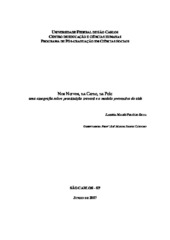| dc.contributor.author | Silva, Larissa Maués Pelúcio | |
| dc.date.accessioned | 2016-06-02T19:24:43Z | |
| dc.date.available | 2007-11-06 | |
| dc.date.available | 2016-06-02T19:24:43Z | |
| dc.date.issued | 2007-06-13 | |
| dc.identifier.citation | SILVA, Larissa Maués Pelúcio. Nos nervos, na carne, na pele : uma etnografia sobre prostituição travesti e o modelo preventivo de AIDS.. 2007. 313 f. Tese (Doutorado em Ciências Humanas) - Universidade Federal de São Carlos, São Carlos, 2007. | por |
| dc.identifier.uri | https://repositorio.ufscar.br/handle/ufscar/1399 | |
| dc.description.abstract | This dissertation looks at the discussion that unfolds within the official STD/AIDS prevention model set up to
provide attention to travestis involved in prostitution in the city of São Paulo. Using ethnographic methods,
I have attempted to investigate how preventive discourse circulates through the travesti universe and what
logic presides over the process, from the point of view of the particular ethos of this clientele. The concerns
within the field have turned toward how AIDS is signified by travestis, the meanings of illness and suffering,
as well as the care that is given to the body and thereby, to the construction of personhood. The project Tudo
de Bom!, housed within the public health organ STD/AIDS City of São Paulo which belongs to the
Municipal Secretariat of Health, provided empirical bases for my study of how the preventive model was
operationalized. My point of departure is the notion that the adopted preventive model - notwithstanding the
specific and differentiated connotation it is given in the case of particular segments - can be characterized by a
scientific and technical rationality and universalizing normative values that are not necessarily compatible
with the social logic that prevails in the organization of the pertinent social networks and the differentiated
values upon which they are based. I go on to suggest the hypothesis that recent public policies devoted to this
segment have focused their attention on bearers of deviant sexualities as a target population - among which
travestis are included - without any greater consideration of the relationship of the latter to the men with
whom they relate sexually. Since these men fall within normalized categories, they become invisible for
hetero-centered health policies that choose their target groups through criteria based on epidemiological
references rather than considering the social and cultural dimensions of relationships in the different contexts
in which these populations act. | eng |
| dc.description.sponsorship | Universidade Federal de Minas Gerais | |
| dc.format | application/pdf | por |
| dc.language | por | por |
| dc.publisher | Universidade Federal de São Carlos | por |
| dc.rights | Acesso Aberto | por |
| dc.subject | Antropologia | por |
| dc.subject | Antropologia da saúde | por |
| dc.subject | Travestis | por |
| dc.subject | AIDS (Doença) | por |
| dc.subject | Gênero | por |
| dc.subject | Travestis [transvestites] | eng |
| dc.subject | AIDS prevention model | eng |
| dc.subject | Sexuality | eng |
| dc.subject | Gender and health | eng |
| dc.title | Nos nervos, na carne, na pele : uma etnografia sobre prostituição travesti e o modelo preventivo de AIDS. | por |
| dc.type | Tese | por |
| dc.contributor.advisor1 | Cardoso, Marina Denise | |
| dc.contributor.advisor1Lattes | http://genos.cnpq.br:12010/dwlattes/owa/prc_imp_cv_int?f_cod=K4781692Z8 | por |
| dc.description.resumo | Esta tese foca a discussão do modelo oficial preventivo para DST/aids voltado às travestis que se prostituem
na cidade de São Paulo. Por meio de pesquisa etnográfica, buscou-se investigar o modo como o discurso
preventivo circula no universo travesti e qual a lógica que preside esse processo, do ponto de vista do ethos
diferenciado desta clientela. As preocupações em campo têm se voltado para a significação da aids entre as
travestis, os sentidos do adoecer e do sofrimento, bem como os cuidados desprendidos com o corpo e, assim,
para a construção da Pessoa. O projeto Tudo de Bom!, alocado na agência pública de saúde DST/AIDS
Cidade de São Paulo (da Secretaria Municipal de Saúde), forneceu a base empírica, no que se refere ao modo
de operacionalização do modelo preventivo. Parte-se do princípio que, mesmo com uma conotação
eventualmente específica e diferenciada para determinados segmentos, o modelo preventivo adotado se
caracteriza por uma racionalidade técnico-científica e valores normativos universalizantes, que não são
necessariamente compatíveis nem com a lógica social que preside a organização dessas redes, nem com os
valores diferenciais que lhes servem de base. Coloca-se, ainda, como hipótese, que as políticas públicas
recentes voltadas para esse segmento focam seu alvo nas sexualidades desviantes (entre estas, as travestis),
sem considerar em profundidade a relação pressuposta entre elas e os homens com os quais se relacionam
sexualmente, por serem estes corpos normalizados e, por isso, invisíveis para as políticas de saúde
heterocentradas. Além disso, elegem os grupos populacionais como alvo , a partir de critérios fortemente
calcados em referenciais epidemiológicos, mais do que nos aspectos sociais e culturais que conformam as
relações nos diferentes contextos em que essas populações atuam. | por |
| dc.publisher.country | BR | por |
| dc.publisher.initials | UFSCar | por |
| dc.publisher.program | Programa de Pós-Graduação em Ciências Sociais - PPGCSo | por |
| dc.subject.cnpq | CIENCIAS HUMANAS::ANTROPOLOGIA | por |
| dc.contributor.authorlattes | http://lattes.cnpq.br/5018385548495872 | por |
